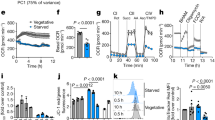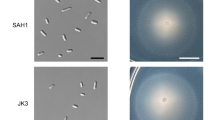Abstract
Chemolithoautotrophic, sulphide-oxidizing (thiotrophic) symbioses represent spectacular adaptations to fluctuating environmental gradients and survival is often accomplished when growth is fuelled by sufficient nourishment through the symbionts leading to fast cell proliferation. Here we show 5′-bromo-2′ deoxyuridine (BrdU) pulse labelling of vegetative growingZoothamnium niveum, a colonial ciliate obligately associated with thiotrophic ectosymbionts, and demonstrate age related growth profiles in three heteromorphic host cell types. At the colony’s apex, a large top terminal zooid performed high proliferation activity, which decreased significantly with increasing colony age but was still present in old colonies indicating that this cell possesses lifelong cell division potential. In contrast, terminal branch zooids proliferated independent of colony age but appeared to be limited by their cell division capacity predetermined by branch size, thus leading to the strict, feather-shaped colony form. Appearance of labelled terminal branch zooids allowed us to distinguish a highly proliferating apical colony region from an almost inactive, senescent basal region. In macrozooids attached to the colony, extensive BrdU labelling suggests that DNA synthesis occurs in preparation for a new generation. As motile swarmers, the macrozooids seem to be arrested in the cell cycle and mitosis and cell division occur when the swarmer settles and transforms into a top terminal zooid buildingup a new colony.
Similar content being viewed by others
References
Alexandrova, O., Solovei, I., Cremer, T., and David, C.N. 2003. Replication labeling patterns and chromosome territories typical of mammalian nuclei are conserved in the early metazoanHydra.Chromosoma 112: 190–200.
Bauer-Nebelsick, M., Bardele, C.F., and Ott, J.A. 1996a. Electron microscopic studies onZoothamnium niveum (Hemprich & Ehrenberg, 1831) Ehrenberg, 1838 (Oligohymenophora, Peritrichida), a ciliate with ectosymbiotic, chemoautotrophic bacteria.European Journal of Protistology 32: 202–215.
Bauer-Nebelsick, M., Bardele, C.F., and Ott, J.A. 1996b. Redescription ofZoothamnium niveum (Hemprich & Ehrenberg, 1831) Ehrenberg, 1838 (Oligohymenophora, Peritrichida), a ciliate with ectosymbiotic, chemoautotrophic bacteria.European Journal of Protistology 32: 18–30.
Cavanaugh, C.M., McKiness, Z.P., Newton, I.L., Frank, J., and Steward, FJ. 2006. Marine chemosynthetic symbioses. In:The Prokaryotes: A Handbook on the Biology of Bacteria. Dworkin, M. et al., eds. Springer Verlag, pp. 475–507.
Clamp, J.C. and Williams, D. 2006. A molecular phylogenetic investigation ofZoothamnium (Ciliophora, Peritrichia, Sessilida).Journal of Eukaryotic Microbiology 53: 494–498.
Ehrenberg, C.G. 1838. Die Infusionsthierchen als vollkommene Organismen.Ein Blick in das tiefere organische Leben der Natur. Leopold Voss Verlag, Leipzig.
Fauré-Fremiet, E. 1930. Growth and differentiation of the colonies ofZoothamnium alternans (Clap and Lachm).Biological Bulletin 58: 28–51.
Fenchel, T. and Finlay, B.J. 1989.Kentrophoros: a mouthless ciliate with a symbiotic kitchen garden.Ophelia 30: 75–93.
Fisher, C.R. and Childress, J.J. 1986. Translocation of fixed carbon from symbiotic bacteria to host tissues in the gutless bivalveSolemya reidi. Marine Biology93: 59–68.
Gratzner, H.G. 1982. Monoclonal antibody to 5-bromo- and 5-iododeoxyuridine: A new reagent for detection of DNA replication.Science 218: 474–475.
Gschwentner, R., Ladumer, P., Nimeth, K., and Rieger, R. 2001. Stern cells in a basal bilaterian. S-phase and mitotic cells inConvolutriloba longifissura (Acoela, Plathelminthes).Cell Tissue Research 304: 401–408.
Hemprich, F.W. and Ehrenberg, C.G. 1831. Symbolae physicae. Evertebrata. I. Phytozoa.Abhandlungen der Akademischen Wissenschaften Berlin.
Ji, D., Song, W., and Warren, A. 2006. Redescriptions of three marine peritrichous ciliates,Zoothamnium alternans Claparède et Lachmann, 1859,Z. sinense Song, 1991 and Z.commune Kahl, 1933 (Ciliophora, Peritrichia), from North China.Acta Protozoologica 45: 27–39.
Kusuoka, Y. and Watanabe, Y. 1987. Growth and survival of peritrich ciliates in an urban stream.Oecologia 73: 16–20.
Markmann-Mulisch, U., Reiss, B., and Mulisch, M. 1999. Cell type-specific gene expression in the cell cycle of the dimorphic ciliateEufolliculina uhligi.Molecular and General Genetics 262: 390–399.
Moore, M., Leavitt, D.F., Shumate, A.M., Alatalo, P., and Stegeman, J.J. 1993. A cell proliferation assay for small fish and aquatic invertebrates using bath exposure to bromodeoxyuridine.Aquatic Toxicology 30: 183–188.
Morris, R.W. 1993. Analysis of cell proliferation data.Environmental Health Perspectives 101: 73–78.
Nakayama, A., Satoh, N., and Sasakura, Y. 2005. Tissue-specific profile of DNA replication in the swimming larvae ofCiona intestinalis.Zoological Science 22: 301–309.
Ott, J., Bright, M., and Bulgheresi, S. 2004. Marine microbial thiotrophic ectosymbioses.Oceanography and Marine Biology: An Annual Review 42: 95–118.
Ott, J.A., Bright, M., and Schiemer, F. 1998. The ecology of a novel symbiosis between a marine peritrich ciliate and chemoautotrophic bacteria.Marine Ecology 19: 229–243.
Palumbi, S.R. and Jackson, J.B.C. 1983. Aging in modular organisms: ecology of zooid senescence inSteginoporella sp. (Bryozoa; Cheilostomata).Biological Bulletin 164: 267–278.
Plickert, G. and Kroiher, M. 1988. Proliferation kinetics and cell lineages can be studied in whole mounts and macerates by means of BrdU/anti-BrdU technique.Development 103: 791–794.
Postberg, J., Alexandrova, O., Cremer, T., and Lipp, H.J. 2005. Exploiting nuclear duality of ciliates to analyse topological requirements for DNA replication and transcription.Journal of Cell Science 118: 3973–3983.
Rinke, C., Lee R., Katz S., and Bright, M. 2007. The effects of sulphide on growth and behaviour of the thiotrophicZoothamnium niveum symbiosis.Proceedings of the Royal Society B274: 2259–2269.
Rinke, C., Schmitz-Esser, S., Stoecker, K., Nussbaumer, A., Molnár, A., Vanura, K., Wagner, M., Hom, M., Ott, J., and Bright, M. 2006. “Candidatus Thiobios zoothamnicoli,” an ectosymbiotic bacterium covering the giant marine ciliateZoothamnium niveum.Applied and Environmental Microbiology 72: 2014–2021.
Sudo, R. and Aiba, S. 1971. Growth rate of Vorticellidae isolated from activated sludge.Japanese Journal of Ecology 21: 70–76.
Summers, F.M. 1938. Some aspects of normal development in the colonial ciliateZoothamnium alternans.Biological Bulletin 74: 117–129.
Tanaka, T. and Watanabe, T. 2003. Spatiotemporal sites of DNA replication in macro- and micronuclei of the ciliateParamecium caudatum.Chromosome Research 11: 153–164.
Vopel, K., Pöhn, M., Sorgo, A., and Ott, J.A. 2001. Ciliategenerated advective seawater transport supplies chemoautotrophic ectosymbionts.Marine Ecology Progress Series 210: 93–99.
Author information
Authors and Affiliations
Corresponding author
Rights and permissions
About this article
Cite this article
Kloiber, U., Pflugfelder, B., Rinke, C. et al. Cell proliferation and growth inZoothamnium niveum (Oligohymenophora, Peritrichida) — Thiotrophic bacteria symbiosis. Symbiosis 47, 43–50 (2009). https://doi.org/10.1007/BF03179969
Received:
Accepted:
Issue Date:
DOI: https://doi.org/10.1007/BF03179969




